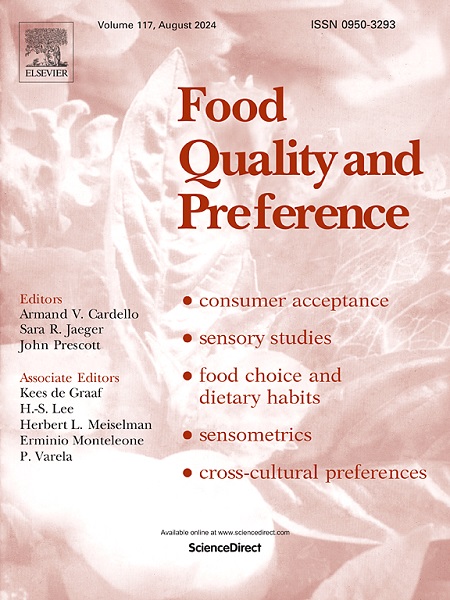Ecological harshness cues modulate food preferences and visual attention: An eye-tracking study
IF 4.9
1区 农林科学
Q1 FOOD SCIENCE & TECHNOLOGY
引用次数: 0
Abstract
Food scarcity in an ancestral environment has led to an evolved psychology that shapes our decision making in eating. To buffer against times of uncertainty and food shortages, humans have a predisposition to prefer foods that are energy dense, and this may be explained by cognitive mechanisms that drive our search and preferences for foods. In the current study, the role of ecological harshness cues (e.g., safety, resource scarcity, violence) and anticipated food scarcity in desirability and visual attention to high vs. low-caloric food items. Participants (N = 142) were randomly assigned to an ecological scenario prime, and they were asked to view images of foods while their eye-movements were being tracked using an eye-tracker, followed by a desirability task. The findings showed that high-caloric foods were rated more desirable, and individuals were faster at recognizing high-caloric foods and directed their visual attention to them longer. More importantly, anticipated scarcity and ecological harshness cues were associated with desirability and visual attention, particularly for the resource scarce condition. In a resource scarce condition, participants with higher levels of anticipated food scarcity were more likely to view high-caloric foods longer and make more frequent visits to those images. The findings demonstrate that ecological harshness cues may prompt individuals to pay more attention to foods that are higher in energy content.
生态严酷提示调节食物偏好和视觉注意:一项眼球追踪研究
在祖先的环境中,食物短缺导致了一种进化的心理,这种心理影响了我们在饮食方面的决策。为了缓冲不确定性和食物短缺的时间,人类倾向于选择能量密集的食物,这可以用驱动我们寻找和偏好食物的认知机制来解释。在目前的研究中,生态严酷提示(例如,安全,资源稀缺,暴力)和预期的食物稀缺在对高热量食物和低热量食物的欲望和视觉注意中的作用。参与者(N = 142)被随机分配到一个生态场景,他们被要求观看食物的图像,同时用眼动仪跟踪他们的眼球运动,然后是一个理想性任务。研究结果表明,高热量的食物更受欢迎,人们更快地识别出高热量的食物,并将视觉注意力集中在它们身上的时间更长。更重要的是,预期的稀缺性和生态严酷性线索与可取性和视觉注意有关,特别是在资源稀缺的情况下。在资源稀缺的情况下,预期食物短缺程度较高的参与者更有可能更长时间地观看高热量食物,并更频繁地访问这些图像。研究结果表明,生态严酷的线索可能会促使个人更加关注能量含量较高的食物。
本文章由计算机程序翻译,如有差异,请以英文原文为准。
求助全文
约1分钟内获得全文
求助全文
来源期刊

Food Quality and Preference
工程技术-食品科技
CiteScore
10.40
自引率
15.10%
发文量
263
审稿时长
38 days
期刊介绍:
Food Quality and Preference is a journal devoted to sensory, consumer and behavioural research in food and non-food products. It publishes original research, critical reviews, and short communications in sensory and consumer science, and sensometrics. In addition, the journal publishes special invited issues on important timely topics and from relevant conferences. These are aimed at bridging the gap between research and application, bringing together authors and readers in consumer and market research, sensory science, sensometrics and sensory evaluation, nutrition and food choice, as well as food research, product development and sensory quality assurance. Submissions to Food Quality and Preference are limited to papers that include some form of human measurement; papers that are limited to physical/chemical measures or the routine application of sensory, consumer or econometric analysis will not be considered unless they specifically make a novel scientific contribution in line with the journal''s coverage as outlined below.
 求助内容:
求助内容: 应助结果提醒方式:
应助结果提醒方式:


